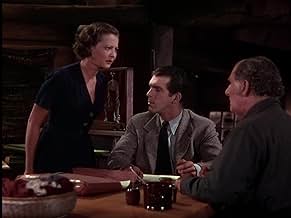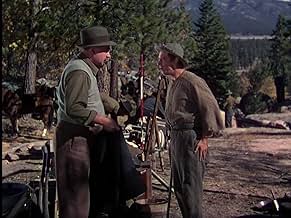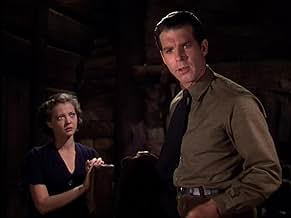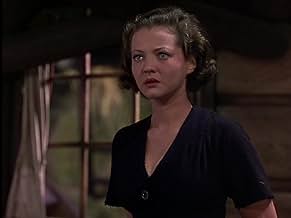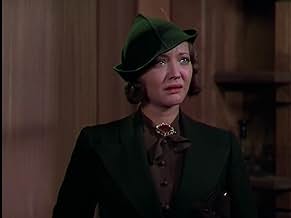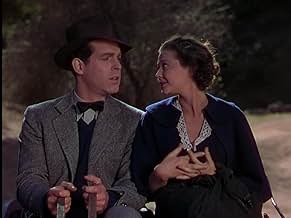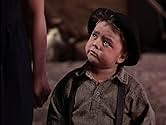IMDb-BEWERTUNG
6,8/10
1478
IHRE BEWERTUNG
Füge eine Handlung in deiner Sprache hinzuA railroad man from the city befriends a mountain girl in a Kentucky family feud.A railroad man from the city befriends a mountain girl in a Kentucky family feud.A railroad man from the city befriends a mountain girl in a Kentucky family feud.
- Für 1 Oscar nominiert
- 5 Gewinne & 2 Nominierungen insgesamt
George 'Spanky' McFarland
- Buddie Tolliver
- (as Spanky McFarland)
Samuel S. Hinds
- Sheriff
- (as Samuel Hinds)
Henry Brandon
- Wade Falin
- (as Henry Kleinbach)
Jess Barker
- Merd Falin
- (as Philip Barker)
Empfohlene Bewertungen
10jsd28
It's a wonderful movie - good story - well written & well acted by a better than ordinary cast. Spanky Mac Farland was a jewel in his role & Fred MacMurry & Henry Fonda performed well. Buelha Bondi proved to be a surprisingly good (to me, at least), actress. She carried more than her share of the movie. The scenery, the filming of that beautiful area, the first movie, shot outside, in color, should have won an Oscar. I'm still disappointed that it didn't. if you haven't seen it - SEE IT!!!
The movie's an affecting tale of feuding backwoods families, who must also make adjustments to encroaching modern world. I was expecting a Romeo-Juliet situation with the families, but that's surprisingly not the case. Instead June (Sidney) has to decide between her cousin Dave (Fonda) and outsider Hale (MacMurray). Tradition favors Dave, but her heart favors Hale. At the same time, railroad developers are crossing land owned by each family, and neither the Tollivers nor the Falins wants to accommodate their hereditary enemy. They'd rather shoot each other if they get the chance. And who knows how the enmity started, except now it's part of both families' tradition. If the movie's flawed, it's with the use of of popular backwoods stereotypes.
Apparently this was the first outdoor Technicolor feature (IMDB), but you'd never know it. Visually the film is quite striking, with a lot of beautiful outdoor compositions. Also, you'd never guess these were filmed just 35-miles east of LA in the San Bernardino mountains. The acting too is first-rate—a soulful Sydney, an ornery Fonda, and an underrated MacMurray. Then there's Sherlock Holmes' favorite Dr. Watson, Nigel Bruce, in a non-comedic role. Needless to say, that took some adjustment for this old Sherlock fan. In fact, there're a couple other unexpected cast members, as well: Little Rascal Spanky McFarland and comedic Fuzzy Knight. And, of course, mustn't forget everyone's favorite hard-scrabble mom, Beulah Bondi, as the long-suffering ma Tolliver.
I like the way the movie works the culture clash between tradition and modernity into the plot. The railroad company pays big money for land use, and that along with a railway to service the expected coal deposits, is bringing the backwoods into the modern age, as June's evolution shows. Of course, not everyone's supportive of change, particularly dad Tolliver (Stone). The movie has some uncommonly poignant moments, especially that final sequence, which conveys an extraordinary emotional power. As a kid, I recall bawling at it, and even now as a geezer, it brought a tear to the eye. As I see it, Fuzzy and his dog are mourning not only friends but the passing of a simpler way of life.
All in all, the movie is surprisingly good, with a strong story, commanding visuals, and a thoughtful subtext. So don't pass it up because of a relative obscurity.
Apparently this was the first outdoor Technicolor feature (IMDB), but you'd never know it. Visually the film is quite striking, with a lot of beautiful outdoor compositions. Also, you'd never guess these were filmed just 35-miles east of LA in the San Bernardino mountains. The acting too is first-rate—a soulful Sydney, an ornery Fonda, and an underrated MacMurray. Then there's Sherlock Holmes' favorite Dr. Watson, Nigel Bruce, in a non-comedic role. Needless to say, that took some adjustment for this old Sherlock fan. In fact, there're a couple other unexpected cast members, as well: Little Rascal Spanky McFarland and comedic Fuzzy Knight. And, of course, mustn't forget everyone's favorite hard-scrabble mom, Beulah Bondi, as the long-suffering ma Tolliver.
I like the way the movie works the culture clash between tradition and modernity into the plot. The railroad company pays big money for land use, and that along with a railway to service the expected coal deposits, is bringing the backwoods into the modern age, as June's evolution shows. Of course, not everyone's supportive of change, particularly dad Tolliver (Stone). The movie has some uncommonly poignant moments, especially that final sequence, which conveys an extraordinary emotional power. As a kid, I recall bawling at it, and even now as a geezer, it brought a tear to the eye. As I see it, Fuzzy and his dog are mourning not only friends but the passing of a simpler way of life.
All in all, the movie is surprisingly good, with a strong story, commanding visuals, and a thoughtful subtext. So don't pass it up because of a relative obscurity.
Only yesterday i was watching an old sitcom "My 3 Sons' starring Fred. I noticed that the teacher's role was played by Sidney...and right away I made the connection to this film, when my big sister took me to the movies. It was my first viewing of a Technicolor movie and as a kid I was anxious to see "Spanky". It was too grown up for me at 8 years old to absorb the story line. I was more taken with the color, Spanky and the song they kept playing throughout. I liked the song and recall, the theater showed a Popeye comedy which was in color also, and the hit song that was played in it was "Did You ever see a Dream Walking, well I did"...I also noticed that my sister and her boyfriend were smooching on sneaks...LOL
This sound version of The Trail of the Lonesome Pine is actually the fourth and to date last version of this story. There were three silent films made from this novel by John Fox, Jr., including one done in 1916 by Cecil B. DeMille.
It's the story of a couple of Appalachian Mountain families who've had a decades old feud in which no one can quite recall how it all got started, but they sure do remember the latest outrage by the other crowd. There's a great temptation to treat this all humorously and it certainly has been done, I can recall Abbott and Costello's Comin' Round the Mountain with the same plot premise. But whole people's and whole nations act this way, who are we to judge the Tollivers and Falins of this story.
Sylvia Sidney and Henry Fonda are two Tolliver cousins, kissing cousins as they say in the mountains, distant enough to contemplate marriage. Into the picture comes railroad man Fred MacMurray who wants to build a railroad through the properties of both families. He interests Sylvia who starts to see that there is a whole world away from her family and their feud.
Of course when her little brother is killed the whole ugly business starts up again and it leaves tragedy again in both families.
The Trail of the Lonesome Pine has its place in film history as the first outdoor as opposed to studio film shot in three strip technicolor. Color which is now standard was a big gimmick back in the day and Paramount raked in good box office.
Fuzzy Knight plays another rustic character, kind of a Tolliver satellite and he sings a couple of songs written for the film by Louis Alter and Sidney Mitchell, Twilight on the Trail and A Melody from the Sky. The latter got an Academy Award nomination for Best Song, losing to The Way You Look Tonight. The former however got a recording by Bing Crosby. This is a perfect example of the connection of film, and radio, and the recording industry. Bing was Paramount's number one box office attraction and the Paramount executives no doubt prevailed on him to record the song and sing it on his brand new Kraft Music Hall Radio Show in the interest of publicizing The Trail of the Lonesome Pine.
Fred MacMurray and Sylvia Sidney were also with Paramount at the time and Henry Fonda was at that time under contract to producer Walter Wanger who filmed this story. Those were the days way before agents and stars being their own producers. Such cozy arrangements as these were more easily done then.
This last to date version of The Trail of the Lonesome Pine probably is too old fashioned for a remake. Still I think today's audiences might still enjoy it.
It's the story of a couple of Appalachian Mountain families who've had a decades old feud in which no one can quite recall how it all got started, but they sure do remember the latest outrage by the other crowd. There's a great temptation to treat this all humorously and it certainly has been done, I can recall Abbott and Costello's Comin' Round the Mountain with the same plot premise. But whole people's and whole nations act this way, who are we to judge the Tollivers and Falins of this story.
Sylvia Sidney and Henry Fonda are two Tolliver cousins, kissing cousins as they say in the mountains, distant enough to contemplate marriage. Into the picture comes railroad man Fred MacMurray who wants to build a railroad through the properties of both families. He interests Sylvia who starts to see that there is a whole world away from her family and their feud.
Of course when her little brother is killed the whole ugly business starts up again and it leaves tragedy again in both families.
The Trail of the Lonesome Pine has its place in film history as the first outdoor as opposed to studio film shot in three strip technicolor. Color which is now standard was a big gimmick back in the day and Paramount raked in good box office.
Fuzzy Knight plays another rustic character, kind of a Tolliver satellite and he sings a couple of songs written for the film by Louis Alter and Sidney Mitchell, Twilight on the Trail and A Melody from the Sky. The latter got an Academy Award nomination for Best Song, losing to The Way You Look Tonight. The former however got a recording by Bing Crosby. This is a perfect example of the connection of film, and radio, and the recording industry. Bing was Paramount's number one box office attraction and the Paramount executives no doubt prevailed on him to record the song and sing it on his brand new Kraft Music Hall Radio Show in the interest of publicizing The Trail of the Lonesome Pine.
Fred MacMurray and Sylvia Sidney were also with Paramount at the time and Henry Fonda was at that time under contract to producer Walter Wanger who filmed this story. Those were the days way before agents and stars being their own producers. Such cozy arrangements as these were more easily done then.
This last to date version of The Trail of the Lonesome Pine probably is too old fashioned for a remake. Still I think today's audiences might still enjoy it.
I bought a video of this film on Amazon.com after reading the 1908 novel by John Fox Jr. and enjoying it very much. I waited 4 whole months for Amazon to locate a copy and ship it to me. Then I settled down to watch it and almost fell asleep. I was disappointed after all that wait.
Sylvia Sidney and Fred MacMurray were terribly miscast as the leads June and Jack, Fred more so than Sylvia. Henry Fonda was very good as Dave, although his lines were hokey. The script was not true to the book at all; that was the main problem. All the protective tenderness the lead male Jack felt for the girl June, so beautifully portrayed in the novel, was totally missing in Fred MacMurray's performance. And then to top it off they had little Spanky from the Our Gang series in it as the little brother of June, his chubby face and coy demeanor were distractions from the main action of the story. The songs that were sung were annoying too; had no place in the story. It would have been better if they had spent money on a better musical soundtrack without characters singing all the time, especially in dramatic scenes. What were they thinking? (no doubt, of sheet music sales). Some outdoor scenes were beautiful filmed in color but that alone cannot hold the viewer's interest in the movie. Even the significance and symbolism of the Pine Tree in June and Jack's relationship wasn't portrayed in the film as it should have been.
Anyway, my advice here is to skip the film and just read the book and enjoy it. Since this story is in the public domain it could really be updated today and make a nice film. Maybe someday some studio or independent filmmaker will consider it. There were 4 silent versions and an animated version made prior to this film, so obviously the story is a classic one that can be enjoyed by new generations, if told well and with sensitivity and faithfulness to the book by John Fox.
Sylvia Sidney and Fred MacMurray were terribly miscast as the leads June and Jack, Fred more so than Sylvia. Henry Fonda was very good as Dave, although his lines were hokey. The script was not true to the book at all; that was the main problem. All the protective tenderness the lead male Jack felt for the girl June, so beautifully portrayed in the novel, was totally missing in Fred MacMurray's performance. And then to top it off they had little Spanky from the Our Gang series in it as the little brother of June, his chubby face and coy demeanor were distractions from the main action of the story. The songs that were sung were annoying too; had no place in the story. It would have been better if they had spent money on a better musical soundtrack without characters singing all the time, especially in dramatic scenes. What were they thinking? (no doubt, of sheet music sales). Some outdoor scenes were beautiful filmed in color but that alone cannot hold the viewer's interest in the movie. Even the significance and symbolism of the Pine Tree in June and Jack's relationship wasn't portrayed in the film as it should have been.
Anyway, my advice here is to skip the film and just read the book and enjoy it. Since this story is in the public domain it could really be updated today and make a nice film. Maybe someday some studio or independent filmmaker will consider it. There were 4 silent versions and an animated version made prior to this film, so obviously the story is a classic one that can be enjoyed by new generations, if told well and with sensitivity and faithfulness to the book by John Fox.
Wusstest du schon
- WissenswertesParamount's first Technicolor feature and the first feature to be shot in Three-Strip Technicolor outside of a studio environment (on location).
- PatzerThe mud on June Tolliver changes thickness and shape between shots. It also changes from wet to dry and then back to wet.
- Zitate
Melissa Tolliver: I was born old...
- Crazy CreditsThe opening credits (except for the Paramount logo) all appear as if they had been printed on tree barks.
- VerbindungenEdited into The Our Gang Story (1994)
Top-Auswahl
Melde dich zum Bewerten an und greife auf die Watchlist für personalisierte Empfehlungen zu.
- How long is The Trail of the Lonesome Pine?Powered by Alexa
Details
- Erscheinungsdatum
- Herkunftsland
- Sprache
- Auch bekannt als
- The Trail of the Lonesome Pine
- Drehorte
- Produktionsfirmen
- Weitere beteiligte Unternehmen bei IMDbPro anzeigen
- Laufzeit
- 1 Std. 42 Min.(102 min)
- Seitenverhältnis
- 1.37 : 1
Zu dieser Seite beitragen
Bearbeitung vorschlagen oder fehlenden Inhalt hinzufügen

